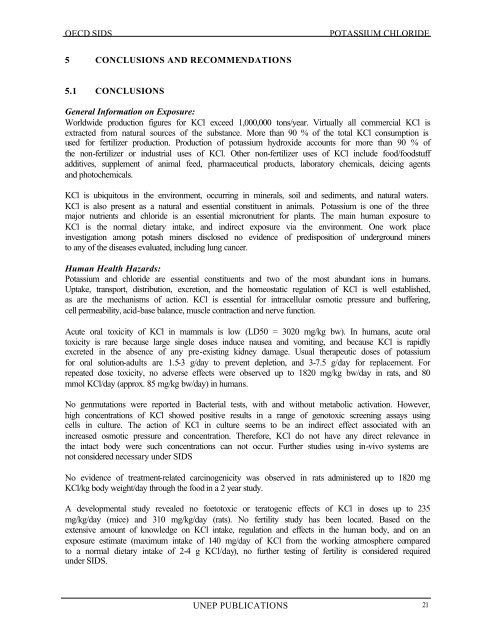POTASSIUM CHLORIDE CAS N°: 7447-40-7
POTASSIUM CHLORIDE CAS N°: 7447-40-7
POTASSIUM CHLORIDE CAS N°: 7447-40-7
You also want an ePaper? Increase the reach of your titles
YUMPU automatically turns print PDFs into web optimized ePapers that Google loves.
OECD SIDS <strong>POTASSIUM</strong> <strong>CHLORIDE</strong><br />
5 CONCLUSIONS AND RECOMMENDATIONS<br />
5.1 CONCLUSIONS<br />
General Information on Exposure:<br />
Worldwide production figures for KCl exceed 1,000,000 tons/year. Virtually all commercial KCl is<br />
extracted from natural sources of the substance. More than 90 % of the total KCl consumption is<br />
used for fertilizer production. Production of potassium hydroxide accounts for more than 90 % of<br />
the non-fertilizer or industrial uses of KCl. Other non-fertilizer uses of KCl include food/foodstuff<br />
additives, supplement of animal feed, pharmaceutical products, laboratory chemicals, deicing agents<br />
and photochemicals.<br />
KCl is ubiquitous in the environment, occurring in minerals, soil and sediments, and natural waters.<br />
KCl is also present as a natural and essential constituent in animals. Potassium is one of the three<br />
major nutrients and chloride is an essential micronutrient for plants. The main human exposure to<br />
KCl is the normal dietary intake, and indirect exposure via the environment. One work place<br />
investigation among potash miners disclosed no evidence of predisposition of underground miners<br />
to any of the diseases evaluated, including lung cancer.<br />
Human Health Hazards:<br />
Potassium and chloride are essential constituents and two of the most abundant ions in humans.<br />
Uptake, transport, distribution, excretion, and the homeostatic regulation of KCl is well established,<br />
as are the mechanisms of action. KCl is essential for intracellular osmotic pressure and buffering,<br />
cell permeability, acid-base balance, muscle contraction and nerve function.<br />
Acute oral toxicity of KCl in mammals is low (LD50 = 3020 mg/kg bw). In humans, acute oral<br />
toxicity is rare because large single doses induce nausea and vomiting, and because KCl is rapidly<br />
excreted in the absence of any pre-existing kidney damage. Usual therapeutic doses of potassium<br />
for oral solution-adults are 1.5-3 g/day to prevent depletion, and 3-7.5 g/day for replacement. For<br />
repeated dose toxicity, no adverse effects were observed up to 1820 mg/kg bw/day in rats, and 80<br />
mmol KCl/day (approx. 85 mg/kg bw/day) in humans.<br />
No genmutations were reported in Bacterial tests, with and without metabolic activation. However,<br />
high concentrations of KCl showed positive results in a range of genotoxic screening assays using<br />
cells in culture. The action of KCl in culture seems to be an indirect effect associated with an<br />
increased osmotic pressure and concentration. Therefore, KCl do not have any direct relevance in<br />
the intact body were such concentrations can not occur. Further studies using in-vivo systems are<br />
not considered necessary under SIDS<br />
No evidence of treatment-related carcinogenicity was observed in rats administered up to 1820 mg<br />
KCl/kg body weight/day through the food in a 2 year study.<br />
A developmental study revealed no foetotoxic or teratogenic effects of KCl in doses up to 235<br />
mg/kg/day (mice) and 310 mg/kg/day (rats). No fertility study has been located. Based on the<br />
extensive amount of knowledge on KCl intake, regulation and effects in the human body, and on an<br />
exposure estimate (maximum intake of 1<strong>40</strong> mg/day of KCl from the working atmosphere compared<br />
to a normal dietary intake of 2-4 g KCl/day), no further testing of fertility is considered required<br />
under SIDS.<br />
UNEP PUBLICATIONS 21
















